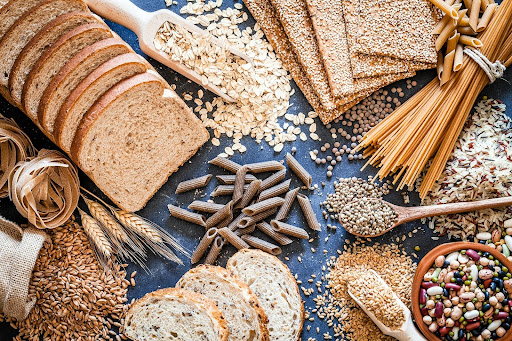Do you know what it means when a product has the label “whole wheat” or “whole grain”? Here are the details on what each of these terms mean, and the difference between the two.
The Difference Between Whole Wheat & Whole Grain
Both whole wheat and whole grain products contain the entire grain kernels. A complete grain kernel has three components: bran, germ, and endosperm. The bran is the fibrous outer layer of the kernel, containing B vitamins and other minerals. The germ, which serves as the reproductive part of the kernel, is abundant in various nutrients, including healthy fats, vitamin E, B vitamins, and antioxidants. The endosperm, the predominant component of the grain kernel, is primarily composed of starchy carbohydrates. 1
Whole wheat products contain complete wheat kernels and no other grains. 2 Whole grain products are any products that contain complete grains, not necessarily wheat. These products might include a mix of different complete grains or just one. Whole wheat products technically are a type of whole grain, but it is more common for products labeled “whole grain” to contain at least one non-wheat grain. Examples of non-wheat whole grains include amaranth, quinoa, brown rice, rye, oat and millet. 3
What is Better, Whole Grain or Whole Wheat?
Whole grain and whole wheat products are both very nutritious (assuming you are not sensitive or allergic to their constituents) and one is not objectively better than the other. A diet rich in whole wheat and whole grain products has been linked to a number of health benefits, including a lowered risk of cardiovascular disease, diabetes, and some cancers. 4 5 6 Whole wheat and whole grain products are a healthy alternative to products that contain refined flour, such as white bread.
Whole grain products that do not contain wheat and other gluten-containing foods are a good choice for those following a gluten-free diet.
How to Choose Whole Wheat & Whole Grain Products
When choosing whole wheat and whole grain products at the grocery store, make sure you read the label carefully. Some products might say “whole wheat” or “whole grain” on the label but only contain 50% whole ingredients and 50% refined flour. Look for labels that say “100% whole wheat” or “100% whole grain.” Conventional grains tend to be highly sprayed in pesticides, so choose organic products when possible.
Anti-Inflammatory Amaranth Cereal
Amaranth, a gluten-free grain known as an Aztec staple food, makes a healthy and cozy breakfast in the cold winter months. Combining it with cinnamon and walnuts adds to the amaranth’s anti-inflammatory effect.
Recipe courtesy of Bastyr University and former students Kelsey Perusse and Mirit Markowitz.
Ingredients
- 1 cup amaranth
- 3 cups water
- 1⁄2 tsp salt
- 2 tsp cinnamon
- 1⁄2 cup walnuts
- 1⁄2 cup currants
- 1 tbsp maple syrup
- 4 tsp ghee (optional)
Instructions
In a small saucepan add amaranth, water, and salt. Bring the amaranth to a boil and then cover and reduce to a simmer for 25 minutes until the amaranth is tender. Once the amaranth is cooked, add cinnamon, walnuts, currants, maple syrup, and optional ghee.
Millet Falafel
This whole grain millet falafel recipe can be made baked or fried depending on your preference and dietary requirements. Enjoy these falafels as a main course served with vegetables or add them to pitas, wraps, and sandwiches.
Recipe courtesy of Bastyr University.
Ingredients
- 1 (15 ounce) can garbanzo beans, drained and rinsed*
- 1 cup mashed cooked sweet potato (about 1 medium)
- ½ cup chopped red onion
- 2 cloves garlic quartered
- ¼ cup chopped flat leaf parsley
- ¼ cup chopped cilantro
- 1 teaspoon ground coriander
- 1 teaspoon kosher salt
- ½ teaspoon ground cumin
- ¼ teaspoon ground black pepper
- ¼ teaspoon cayenne (optional)
- 1 cup cooked millet at room temperature
- 1-2 tablespoons chickpea flour*
- Grapeseed oil for frying*
Notes:
*If you want a firmer texture, use dried garbanzo beans instead of canned. To do this, take 1 cup of dried garbanzo beans and soak in water overnight (up to 24 hours). The beans should absorb enough water to be soft. Once cooked, they will provide a firmer, less mushy texture to the falafel.
*If you do not have chickpea flour, any flour will work. Just keep in mind the flavor it might impart on the falafel.
*Any high heat oil will work. Refined coconut oil, safflower oil, or sunflower oil are good alternatives.
Instructions
Place the garbanzo beans, sweet potato, onion, garlic, parsley, cilantro, coriander, salt, cumin, black pepper and cayenne (if using) into the base of a food processor. Alternate between pulsing and blending, stopping to scrape down the sides of the bowl occasionally, until all of the ingredients in the mixture are uniform in size, but still slightly grainy in texture.
Transfer the mixture to a mixing bowl and gently fold in the cooked millet.
Roll a small amount of the falafel mixture into a 1 – 2-inch sized patty with your hands. It should hold together nicely and not fall apart (If it seems too wet, sprinkle the mixture with a small amount of chickpea flour, no more than a tablespoon at a time, and fold it in). Repeat the shaping process with the rest of the falafel mixture and place the uncooked falafel on a large plate or baking sheet until ready to cook.
To Pan-Fry (For Crispy Falafel):
Heat a large skillet over medium-high heat. Pour 2-3 tablespoons of oil in the skillet and swirl to coat. Place the falafel patties in the skillet and cook for 2-3 minutes on each side, until crispy and browned. Transfer to a paper-towel-lined plate to absorb the excess oil and sprinkle with coarse salt, if desired.
To Bake (For Not-So-Crispy Falafel):
Preheat the oven to 400ºF and line with parchment paper. Mist paper with oil, or use a pastry brush to brush a little oil where you will be placing your falafel. Place the falafel onto the baking sheet and mist the tops with additional oil; bake for about 25 minutes, flipping halfway through cooking time, or until golden brown on the outside.








